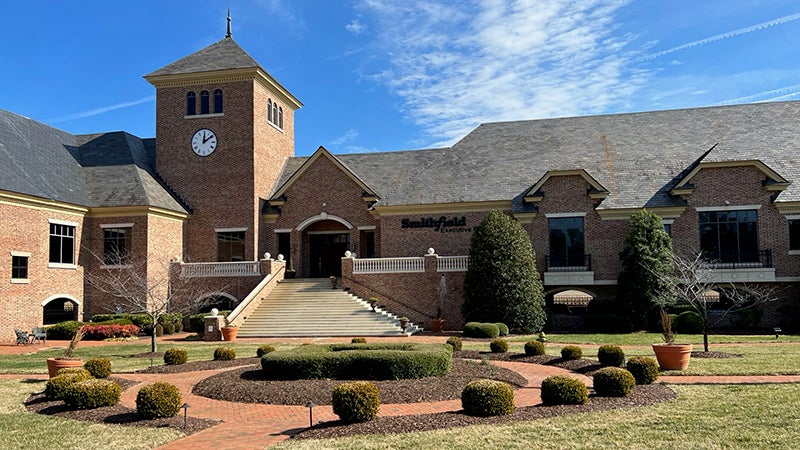Hunting down Arthur Smith’s DNA
Published 8:13 pm Tuesday, December 3, 2019
By Frederic Lee
Staff writer
The hunt for the grave of Arthur Smith IV — the man who founded the Town of Smithfield in 1752 — may now include a DNA test from graves at Windsor Castle Park and funding from the town.
Smithfield Mayor Carter Williams briefed Town Council on the ongoing project to locate Smith or possible descendants at a town committee meeting two weeks ago, reviving the effort that began several years ago.
“We really need to know where the founder of the town is buried,” said Williams in an interview on Nov. 22, adding that the knowledge would enhance the town.
The only way to know definitively is to test the DNA of the grave’s contents compared to a living descendent of Smith through coordination with the Smithsonian Museum, according to Williams. {mprestriction ids=”1,2,3,4,5,6″}
Normal 0 false false false EN-US JA X-NONE /* Style Definitions */ table.MsoNormalTable {mso-style-name:”Table Normal”; mso-tstyle-rowband-size:0; mso-tstyle-colband-size:0; mso-style-noshow:yes; mso-style-priority:99; mso-style-parent:””; mso-padding-alt:0in 5.4pt 0in 5.4pt; mso-para-margin:0in; mso-para-margin-bottom:.0001pt; mso-pagination:widow-orphan; font-size:12.0pt; font-family:”Cambria”,serif; mso-ascii-font-family:Cambria; mso-ascii-theme-font:minor-latin; mso-hansi-font-family:Cambria; mso-hansi-theme-font:minor-latin;}
Smith’s great grandfather was the original owner of the Windsor Castle property, and has a line of descendants that were involved in Virginia government and the military in the 17th and 18th centuries, according to a status report on the project provided by Williams.
Prior to 1637, the area was occupied by the Warraskoyack tribe, according to the report.
Williams said that he’s been working on the project for several years, and that there’s a tombstone that’s been found at the park that seems like it “probably” belongs to Smith because of its material.
Jennifer England, director of the Isle of Wight County Museum, said that the process to scout out potential gravesites at Windsor Castle Park included the use of ground penetrating radar, which was conducted by Tim Horsley, managing director of Horsley Archeological Prospection, LLC.
The preliminary report shows more than 40 possible graves at Windsor Castle Park, with two evident tombstones and one footstone located in an old cemetery at the park.
Williams said that the cost to complete this project is tentatively estimated at $35,000, but would depend on what type of deals the Smithsonian Museum has to offer in terms of DNA testing. If the first grave that is exhumed ends up containing the bones of Smith, Williams said that would end the project.
The cemetery is roughly 200 yards northeast of the Windsor Castle manor house, situated on a rise overlooking Cypress Creek and about 1,500 square feet in size.
One of the tombstones bears the name Arthur Smith Whitehead, with birth and death dates of Aug. 26, 1882 and Dec. 25, 1921. The second has the name Richard Goodwin, who lived from March 22, 1830 through June 14, 1870.
England said that it’s likely that the Whiteheads were related to the Smiths.
Two unidentified graves also rest at the site, one with a brick vault and covered on the surface with mortar, and another grave built of slate, according to the report.
Williams thinks that there’s a good chance that the slate grave is Smith’s, since it’s built of expensive material from England that would only be available to the affluent.
A permit from the Virginia Department of Historic Resources is required to exhume a grave, and that permit is based on factors including the disposition of the human remains and family consent, among others, according to the report.
The slate grave was “rediscovered” by the Isle of Wight Historical Society in 2004.
In addition to those four gravesites, the ground penetrating radar report shows 41 other spots at the old cemetery that may be gravesites.
According to a project status report from Williams, ground penetrating radar is used in archeological geophysics to detect and map subsurface archeological artifacts, features and patterning.
Williams said that he’s been working on this project for about three years and, after coming up short in terms of people who’d like to donate to the effort, he’s now planning to ask Town Council to fund the project.
Williams said that there are about $225,000 in tax credits realized from the Windsor Castle Park restoration project that could be tapped for the project, but added that funding the project and where that funding would come from would be a decision of Town Council.
Williams said England will give a presentation on the hunt for Smith’s grave at the Dec. 17 Parks and Recreation committee meeting.
A more extensive report from Horsley on the old cemetery is pending, according to Williams. {/mprestriction}





